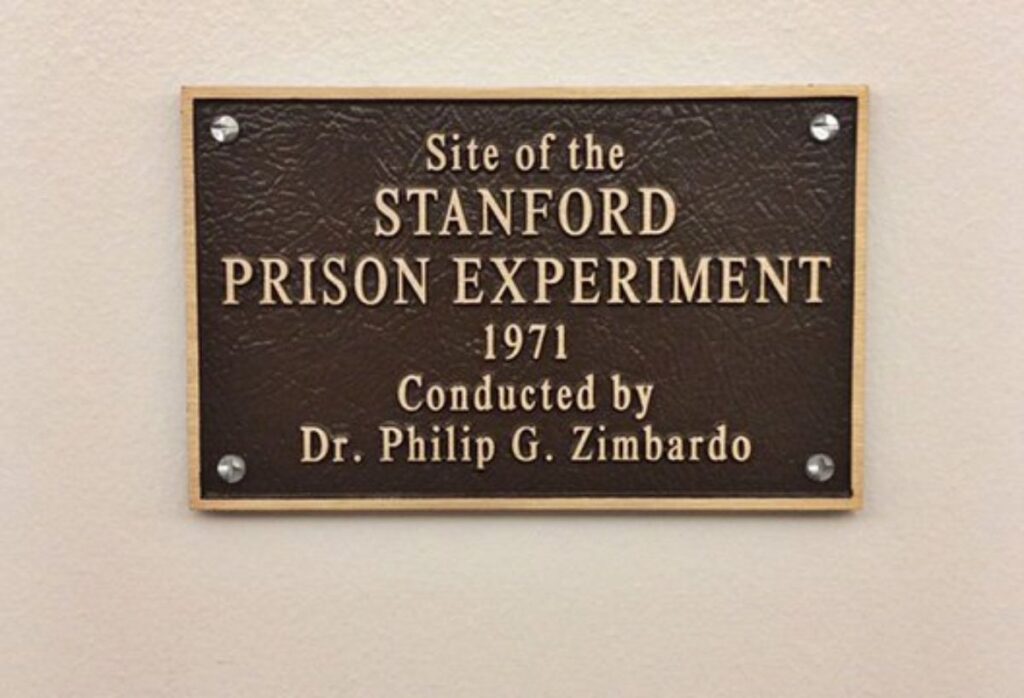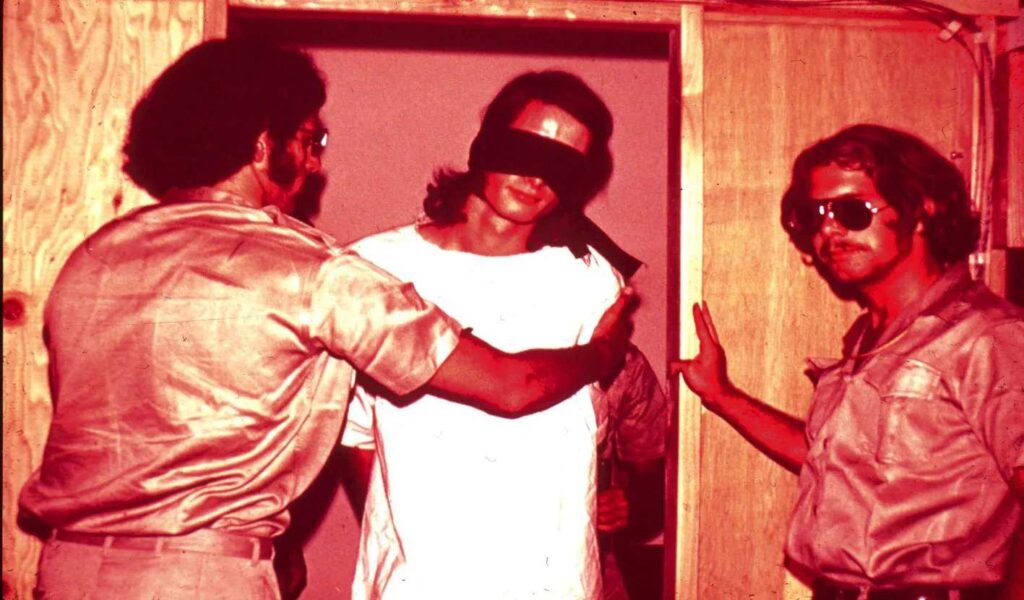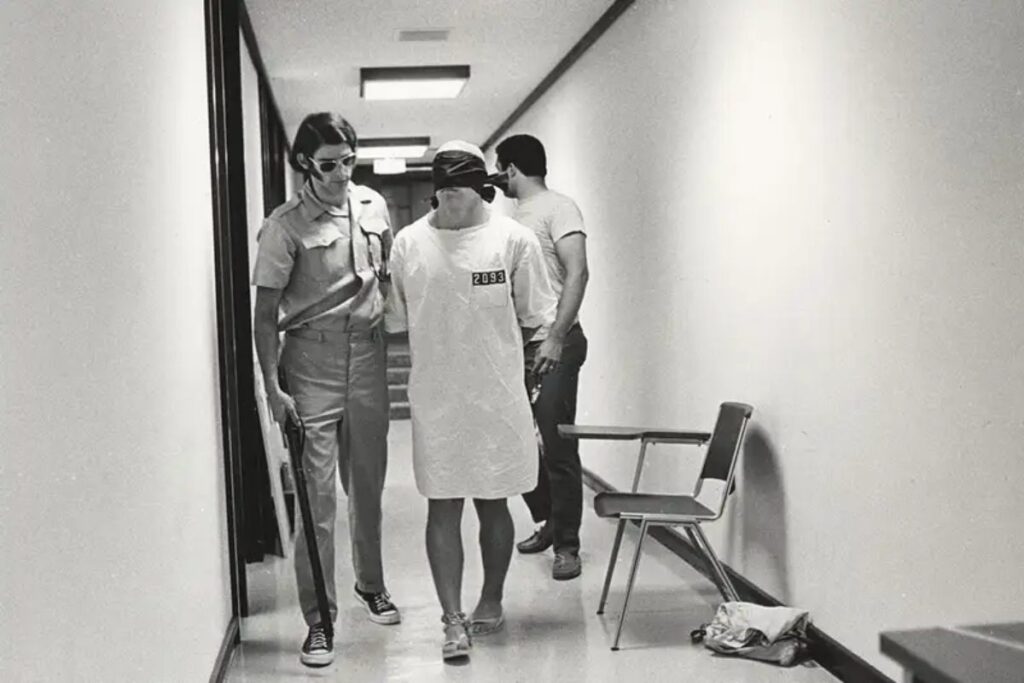In 1971, a group of college students was locked up in the basement of Stanford University’s psychology building. But not against their will. They had agreed to stay in this Stanford prison as part of a study by psychologist Dr. Philip Zimbardo.
The experiment was straightforward and was expected to last only a few days. Or so they thought. But what was expected to be a harmless psychological roleplay soon turned into a terrifying story.
The Stanford Prison Experiment has become a lesson to humanity. It was a perfect example of how quickly humans can lose their sense of right and wrong. It showed that only a few days of pressure or power could turn humans into monsters.
Planned to last two weeks, the Stanford Prison Experiment ended in just six days. It is one of the most disturbing and famous unethical psychology studies in the history of human psychology.

Let’s delve into an experiment gone wrong and how a role-play turned into a nightmare, exploring how imprisonment exposes the extremes of human behavior and the corruption of power.
The Plan: What Was the Stanford Prison Experiment?
Psychologist Philip Zimbardo was curious to understand situations in psychology. Specifically, how people react to being locked up in prison, so he devised a controversial experiment.
Dr. Zimbardo didn’t consider using real prisoners. He wanted raw and real results. So, he went for college students, some of the most educated and refined individuals in society.
He also needed correctional officers for his plan. Again, not the career prison guys. He wanted regular and everyday people in society. Would they change their behavior if they found themselves in a position of power?

The first stage of the plan was to find a mock prison. He spotted the perfect location—a basement beneath Stanford University’s psychology building.
Next, he sought volunteers. He placed an ad in a newspaper, asking people to participate in a groundbreaking study about prison culture.
On the second day, things started to change. Some prisoners became restless. They defied the guards’ orders and blocked the prison doors with their beds.
Seventy-five people responded. Out of them, he chose the 24 healthiest and smartest ones—all young male college students.
He assigned them at random to serve as the prisoners or correctional officers. He ensured that none of them had any previous run-ins with the law or prior convictions.
They were also mentally sharp and in good psychological shape. He assured them that they could end their participation and exit the prison at any time they pleased.
Zimbardo oversaw the whole operation, serving as the overall head of the prison. He got one of his colleagues to act as the Warden. Before we delve into their prison time, let’s discuss their fascinating arrest.
The Arrest: When Pretend Became Too Real
The Stanford Prison Experiment began on August 14, 1971. The students were caught unawares and arrested on the same day in a way they never saw coming.
Zombardi went the extra mile to make the experiment feel as realistic as possible. To this end, they arranged with real law enforcement to have the participants arrested.
Suddenly, that day, police stormed the students’ homes, placed them in handcuffs, searched them, and led them away in official police vehicles. The students finally confirmed what was at play when they got to the prison.
On entering the prison, they were asked to strip off their clothes and change into prison wear. They were assigned prison numbers, and from that time on, they were addressed by those numbers rather than their names.
The guards also had their kits, which included uniforms, sunglasses, and wooden batons. They were also instructed to use only non-violent means in performing their duties.
Day by Day: The Rapid Fall Into Abuse
The Stanford University Experiment began pretty calmly. Everyone was at ease. The inmates took the time to get to know one another and share jokes with each other. The guards were friendly. It was all fun.
On the second day, things started to change. Some prisoners became restless. They defied the guards’ orders and blocked the prison doors with their beds.

The guards were upset and soon lost their cool. They became violent and broke into the cells. Guards humiliated the rebellious prisoners by stripping them naked and seizing their beds.
They went a step further by sentencing inmates who continued in their resistance to solitary confinement. They couldn’t control their newfound power.
On the third day, things got even worse. The guards thought up even more severe and degrading punishments.
They ordered the prisoners to scrub toilets with their bare hands. The guards also denied prisoners sleep and practiced several more cruel practices. Although not all the guards were brutal, the more compassionate ones didn’t challenge their cruel colleagues.
The prisoners began to break down under the harsh conditions. Some even began to weep. Others went on hunger strikes. Yet, some stayed calm and modelled obedience to authority.
Reports stated that one of the inmates had a mental breakdown and was removed from the facility on the third day. But Zimbardo refused to end the experiment. He was determined to see it to the end.
By the fifth day, it no longer resembled an experiment. The guards were fully intoxicated with power. They became even more brutal to their uncooperative wards. Prisoners became even more desperate. Some began to plead pitifully for their freedom. But their appeals fell on deaf ears.
Within us lies the possibility of unimaginable evil. It calls for a sober reflection and a guarding of our hearts.
Zimbardo had also succumbed to the corruption of power. He became even more inconsiderate and determined to see the project through to completion. He busied himself with administration rather than the plight of the inmates.
It took the intervention of a visitor to end the horror show. On the sixth day, Zimbardo’s girlfriend visited him. Christina Maslach, Zimbardo’s lover, was irritated by what she saw. She immediately called him to order with one statement: “What are you doing to these boys?”

The utterance brought Zimbardo back to life. It then dawned on him that he had violated the ethics of social psychology. He finally realized that he had gone too far.
He saw the state of the inmates who were six days from madness. The next morning, he ended the experiment and released everyone. Even he couldn’t believe what he had become.
The Fallout: What Can We Learn?
The report of the Stanford University Experiment reached the public. As expected, it was greeted by shock. It also provoked some crucial questions and taught some lessons.
First was the power of corruption.
- Power Can Change Even the Best of Us
It was remarkable how previously compassionate individuals transformed into their opposites after gaining power. Even after they were instructed not to use it excessively, they couldn’t resist the urge to do so.
- A Loss of Identity Strips People of Their Dignity
By referring to the prisoners by their numbers rather than their names, the guards robbed them of their identities. This humiliation produces a horrible psychological effect.
It made it even easier to subdue them. In addition, it gave the guards or oppressors further justification to maltreat them. They were less than humans in their eyes. They were mere numbers. Statistics.
- Going Beyond the Boundaries of Research
Social psychology ethics do not allow the maltreatment or dehumanization of participants. The Stanford University Experiment went beyond these bounds. Although the participants gave their approval to the process, they weren’t expecting what it ultimately became.
Society adjusted after this experiment. Stricter regulation was introduced to protect future participants and ensure that the conditions of the research would never be repeated.

Zimbardo defended his actions for many years. He argued that the experiment had to escalate to the levels it got to for it to reveal the outcome successfully. However, he later changed his mind and admitted that he had gone too far.
Conclusion: The Prison Within Us All
The Stanford Prison Experiment wasn’t just that. It carried practical lessons for the future of humankind.
The experiment evoked genuine fear and callousness. All it took was six days, and the students were consumed by power, setting aside their humanity and morality.
What played out in the Stanford University basement can happen to anyone. It has taken place throughout history, from the murderous dictatorial regimes of many nations to the slave trade of Europe and America.
The Stanford University Experiment can happen again, but in different ways. That’s why the incident must never be forgotten. It is a testament that within us lies the possibility of unimaginable evil. It calls for a sober reflection and a guarding of our hearts.
Evil tendencies can creep in slowly. Those who will retain their humanity are those who spot them on time and put their souls back in check.
Put yourself in the guards’ shoes. Do you think the power would have corrupted you, or would you have resisted the urge to be cruel? Let’s hear your thoughts.

